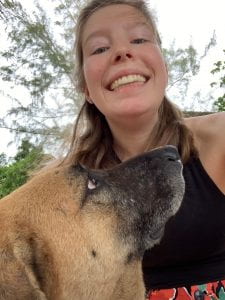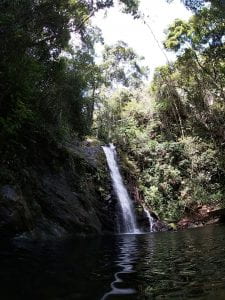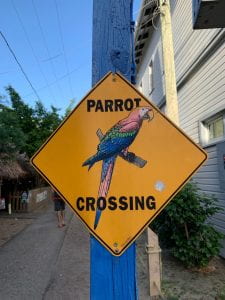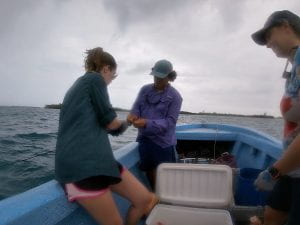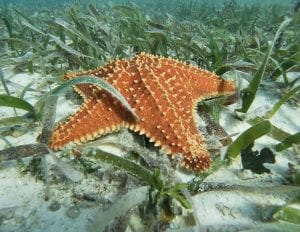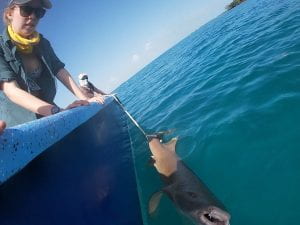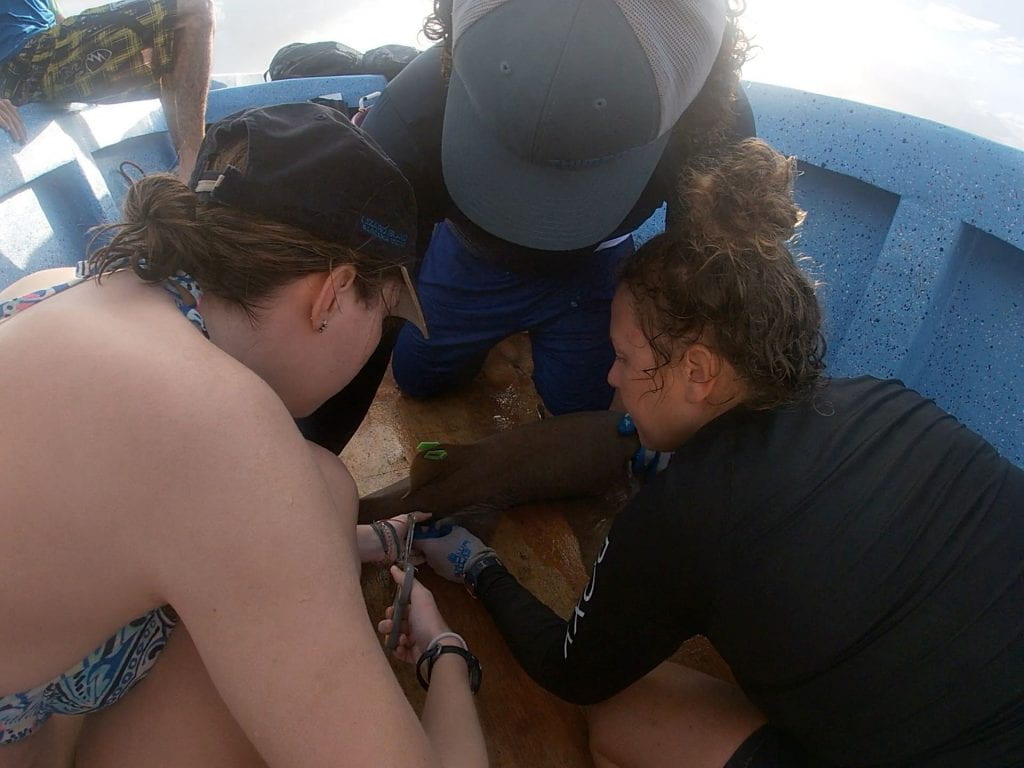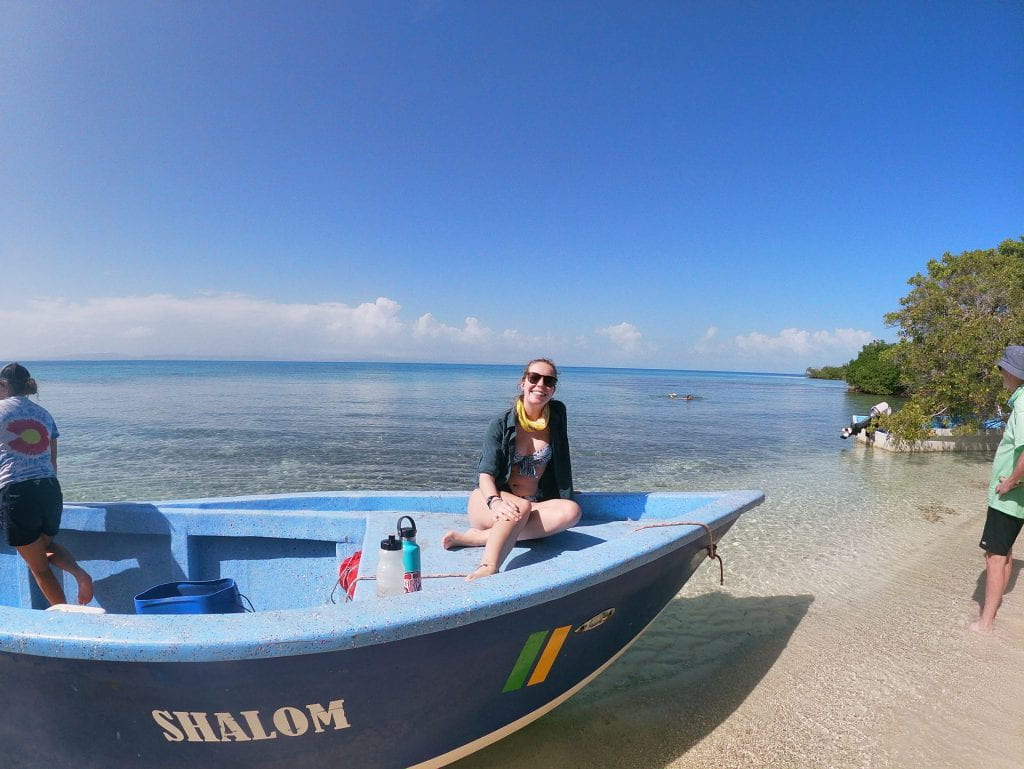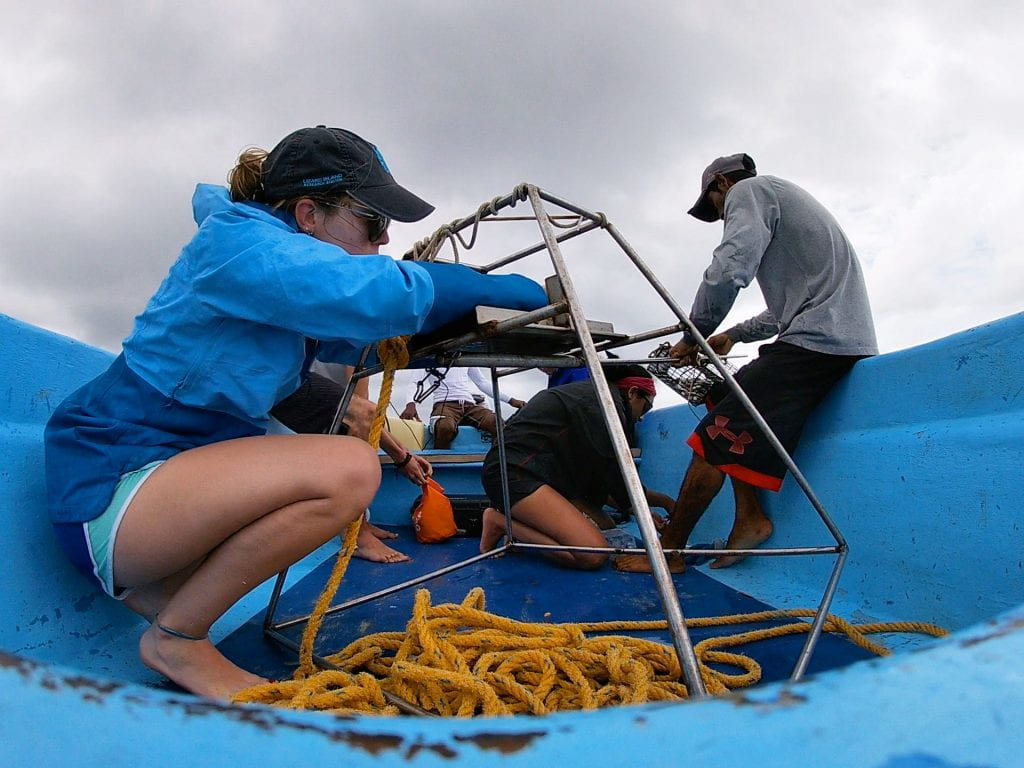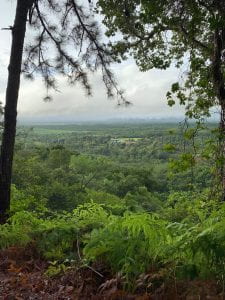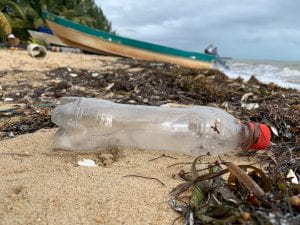This past January I spent a week living in a coastal fishing community in Riverside, Belize as a Horacek Global Conservation fellow. Through Cornell’s partnership with Earthwatch I was able to participate in the Shark and Ray Conservation program in partnership with Florida International University (FIU). Sharks are an incredibly important part of my life and are the driving force behind my career path of shark ecology. The invaluable experience I gained through this program allowed me to make professional connections with top tier graduate school programs and gave me hands on experience with sharks that not only allowed me to diversify my professional skill set for my industry but gave me the opportunity to embrace my passions. I would like to extend my sincere thanks to Muriel Horacek, her husband, and Dr. Stephen Morreale for giving me this opportunity. It was the trip of a lifetime and I will be forever grateful.
Day 1
There’s something about starting an adventure from the driver’s seat that lets you know you’re in for a wild ride. From the copilot’s seat of a small passenger plane I began my week long journey in Belize. After a swift take off I watched the lush rolling hills meet the crystal blue sea from the large windows at the front of the plane. With one of my hands strapped to a GoPro capturing the stunning view I watched as we flew over endless rows of banana farms and citrus orchards cutting apart the rugged landscape with their uniform patterns. Towering puffy clouds cast dancing shadows as we slowly circled in on our destination, Placencia. The narrow peninsula came closer into view as we descended heading straight towards the smallest runway I had ever seen. With the turquoise water visibly glistening at the end of the runway welcoming us we landed and deboarded the plane.
After several hours of becoming wildly familiar with the airport waiting room our team coordinators arrived to take us to our home for the week. The bumpy van ride to Riverside brought us past local homes and restaurants and sharply contrasting high end resorts and tourist villas all within minutes of each other. As we pulled up to our housing for the week I could see hammocks framed by lightly swaying palm trees. As we exited the car we were greeted by a cacophony of barking dogs eager to meet the new strangers who would be staying on their territory. After a friendly introduction to our new canine neighbors we were introduced to owners of the homes we would be staying in.
Alberto and Desiree are a lovely couple whose story was one of the highlights of my week. Former shark fishermen the couple had met Demian several years ago when he moved his research from Glover’s Reef to Riverside. The opportunity with Dr. Chapman’s lab I soon learned offered them the chance to stop shark fishing and help aid in the protection of the precious natural resources. As fisherman they still rely on the health of their local reefs for income and are incredibly grateful for the opportunity to not only have found an income opportunity that does not endanger their lives in the same way as shark fishing but gives them the opportunity to work with their government to protect their reefs and their resources from overexploitation.
After settling into our new bunks and taking the first of what would be a week of ice cold showers I stepped out onto the beach to enjoy the evening. Relaxing in the hammock in the setting sun I reflected on what the week might hold. With crazy weather conditions predicted for the week I was nervous but hopeful that we would have the opportunity to get out on the water and see what the ocean had in store!
Day 2
Waking up to the sound of children yelling and dogs barking I slowly opened my eyes to the glowing morning sun. After getting ready we were treated to a traditional Belizean breakfast. I loaded my plate with fried jacks, refried beans, and eggs with peppers, tomatoes, and cheddar cheese. Stuffing my jacks with eggs and beans I enjoyed my makeshift breakfast taco washing it all down with a glass of fresh watermelon juice. After a quick clean up we sat down to meet the team.
After a night of rest the group was starting to get over their jetlag and we finally got the chance for some proper introductions. Our team leaders from Dr. Chapman’s lab were PhD candidates Jess and Devanshi. The other group members were from all over the world including Egypt, Turkey, and Argentina in addition to the United States. Ready to begin the week’s work we listen
ed to a series of presentations on the Predator Ecology Lab at FIU, the Earthwatch project we would be collecting data for, and of course the types of sharks and rays we might encounter on our trip. The most commonly caught sharks we could expect to see we were told were nurse sharks, Caribbean reefs, sharpnose sharks, and blacktip reef sharks. Even so I had my fingers crossed for something big, like a tiger or hammerhead shark.
To make sure we were prepared to handle a shark out on the water our team gave us a quick lesson in shark work up technique. We got to see how all the tools worked from fin clippers to the leather puncher used to puncture the dorsal fin to the highly complicated tape measure. To make sure we would get accurate body measurements they had us practice measuring different objects and filling out the data sheets we would be using on the boat. Seeing the tools I could hardly contain my excitement about getting to head out on the water the next day!
Day 3
Pouring rain and storm clouds greeted us early the next morning crushing our chances of getting out on the water. But where better to hang out in the rain than in the rainforest! After packing our bags for the day we headed out to check out what inland Belize had to offer! After a ride through the Belizean countryside we took a sharp left turn into a jungle adventure park. With zip lining and tubing available most of the group opted for the more relaxed option of swimming in a stunning waterfall. The drive in brought us through rows and rows of orange trees some with bags of fruit waiting patiently against the trunk for someone to take them away. The bumpy ride brought us right up to the waterfall entrance complete with a restaurant and bar. A short hike up the hill brought us to the larger falls set in a gorgeous rainforest clearing.
With the sun finally peeking out from behind the clouds we decided to try out the water. I walked down the ladder my chacos still on out of fear of what might be on the bottom feeling my feet hit the icy water. My slow progression into the water required a careful acclimation to the freezing temperatures with each step down sending more and more goosebumps up my spine. In my snail paced decent a group of cleaner fish had taken a keen interest in my legs softly biting my toes and calves. With a deep breath I took the plunge into the water swimming out into the open pool to enjoy the view. The rest of the afternoon was spent enjoying the falls and dining at the nearby restaurant snacking on a mix of appetizers while fighting off mosquitoes.
To finish off our day of travel we headed into downtown Placencia to get acquainted with the city. We spent the early evening wandering between artisan craft stands and tourist shops admiring the various wood carvings and hand woven bags. It was fascinating learning about the wood carvings and how all of them were made from local native Belizean tropical hardwoods each with its own special color. To cap off the night we headed down to the beach to enjoy some cocktails and dinner with full view of the waves in the setting sun. Once back at our housing site I crawled up into my bunk bed exhausted from the days sightseeing but eager to get out on the water.
Day 4
I woke up on day four knowing it was going to be a good day. The sun was shining, the ocean was glittering, and we had french toast and fresh fruit for breakfast. I could barely contain my excitement as we got ready to head out on the water. Armed with my field shirt and buff to protect myself from the blazing sun I was first in the shark fishing boat. Despite the sun it was pretty windy
so the team decided to stay relatively close opting to drop out longlines and BRUV off a small island a 25 minute boat ride from the mainland. To deploy the longlines we had to attach a series of hooks to the main line using large tuna clips to ensure they wouldn’t break. I got to attach the clips to the main line as we rather quickly set our first line. While faster than expected I loved getting to jump right in and getting to learn how to deploy the longlines. I had always had a really negative context associated with longlining connecting them with shark fishing and shark culling so it was really cool to see them being utilized for research purposes.
After we had successfully set two lines we decided to head into the island for a lunch break. We soaked up the sun and enjoyed sandwiches and coconut cake while looking out at the water. We sat two eagle rays jump out of the water, one right in front of our boat, and a pod of dolphins off in the distance. After lunch we went to go and check our lines. We pulled in the first line checking the bait on each hook getting all the way to the end until finally we pulled up our first shark! She was too small for us to pull into the boat so the team leaders secured her to the side of the boat before we began our work up. Everyone in the boat had a specific job in the work up and mine was tagging. I have spent my entire life dreaming about tagging a shark and in the moment I could barely contain my excitement. After getting the measurements it was my turn to tag.
I slowly leaned over the side of the boat leather puncher in hand to punch a hole in the dorsal fin. I grabbed the fin feeling the roughness of the dermal denticles between my fingers squeezing my hands together to puncture the fin. With a hole successfully made in the fin it was time to insert the tag. I read out the ID number on the tag, #886, before placing the tagging device over the hole. It took a few tries but with a little bit of elbow grease the tag was in. With a quick fin clip and the hooked removed we set her free before moving on to the next line. Having successfully checked and re-baited the lines and worked up another shark we headed back in to take a snorkel break. In the water we saw lots of starfish, box fish, and healthy coral. On our swim back I was approached by an overly interested barracuda. He started swimming directly at me several times before swimming back out of line of sight to pop back in again swimming towards me. I was happy to get out of the water to escape my overly curious stalker and get back in the boat to check our lines.
With the sun starting to set we checked our first line and cleared it of bait before pulling it back into the boat. On our second line we pulled in another shark! This one was small enough to get into the boat and I got the opportunity to finclip it. While I felt a little guilty cutting off a piece of its pectoral fin I knew it wouldn’t be hurting the shark and the DNA collected from the clip could be used in new and critical studies down the line. Once we had successfully released the shark we pulled in the rest of the line. With clouds rolling in and rain starting to fall we made our way back to the mainland to get dry and warm up with a nice cup of tea. After a quick shower we enjoyed a lovely dinner of stewed chicken and rice before heading off to bed full and exhausted from a day out in the sun.
Day 5
Day 5 once again began with unpredictable weather. I woke up to the sound of pouring rain and heavy winds which soon receded to be replaced by sun. With the weather clearing up and the possibility of a boat day looking promising we got ready and prepared for a day on the water. For our second day out on the water we switched boats to give everyone in the group the opportunity to work up sharks and deploy BRUVs. That meant I would be on the BRUV boat helping bait and deploy the video systems. We took an hour and half boat ride out to South Water Caye Marine Reserve to deploy our survey systems. Setting up and deploying the BRUVs was much faster than deploying the longlines and required the attachment of a GoPro camera and the baiting of the bait box before tossing them over the side. After dropping the BRUVs we went and met up with the longline boat who were still in the process of deploying the lines. With an hour and half of wait time on the BRUVs we pulled out some snacks and enjoyed the beautiful view. As the retrieval time for the BRUVs drew closer the sky began to darken and walls of rain started to close in. With the weather quickly turning we retrieved the BRUVs and waited for the other boat to finish pulling in the longlines. They successfully caught and tagged one small nurse shark in addition to a large barracuda and an eel. As it began to downpour we headed back into the mainland with the rain pelting into our backs.
Once back on the mainland the rain continued with predictions of thunderstorms heading out into the rest of the week. With the water looking uncertain we made plans the for next morning to get an early start on the day to go and see a colony of scarlet macaws that lived about an hour drive from our home base.
Day 6
Our day began at 4:30 am with me stumbling out of bed in the darkness and getting dressed with the sound of rain echoing off the tin roof. Taking advantage of the car ride to get in a few more precious moments of sleep I dozed off. We met Jess and Devanshi at the home of our tour guide to pick him up and head for the Red Bank, the site of the macaw colony. Our drive into the hiking spot was quite the adventure. The pouring rain had flooded the dirt road turning it completely to mud. With no way to turn around we had committed to making it to the hiking trail. After having to be towed out of the mud by the other car four times we finally made it to the trail. Armed with my rain jacket and GoPro we headed for the hills hiking up 20 mins into the young jungle surrounded by the sound of pouring rain and rainforest birds. At the top we reached a clearing that let out onto a beautiful view of the countryside and the far off mountains.
It took about 30mins before we saw our first macaws, a single pair fly by in the distance followed by four or five more pairs of the beautiful birds. Their bright colors are noticeable even from so far away. After an hour of waiting hoping to see them up close we had all but given up hope and were about to head back down when four birds flew right over head giving us an amazing glimpse of their bright red, blue, and yellow coloring.
Mudding and hungry we headed back to camp to have some hard earned breakfast followed by a quick nap. Later that afternoon the group sat down and got to measure a bag of anal fins that had been brought in by a local fisherman. The anal fins could be used to help determine the size of the shark they came from allowing Jess and Dr. Chapmans lab to determine the size and species of the sharks being caught in the area. Such a novel research method was incredibly interesting and I loved the opportunity to learn about new ways his lab was finding to study the shark fishing trade.
Day 7
Another day of inclement weather canceled any opportunity for getting out on the water early. After sleeping in a few extra hours and enjoying a leisurely breakfast I decided to take the day to explore the small stretch of beach in front of our house. While beautiful from afar up close the beach was littered with trash. By no fault of their own the current and constant easterly winds brough heaps of trash ashore to the beach littering it with various bottles and plastic containers. I saw everyday products like deodorant, cleaning products, plastic drink bottles, and pens mixed in with old fishing nets and buoys. It was heartbreaking seeing this beautiful place completely dominated by plastic. And this was just what I could see, I couldn’t imagine the number of micro plastics and plastics bags that had to be out there in the open water being eaten and consumed by marine animals. It made me take a second to think about all of the plastic items I use in my everyday life; toothbrushes, flip flops, dish soap, and hundreds of other products you don’t even think about. I made a list of all the items I wanted to try and replace in my life with plastic free ones. Currently I use shampoo and conditioned bars to make my shower plastic free but switching all of the soap in my house to bar soap reduces plastic waste. Purchasing bamboo toothbrushes and reusable mesh produce bags at the grocery store. There are so many alternative products that I’m lucky enough to be able to afford to get that I should be utilizing to reduce my personal carbon and plastic footprint.

View of beach from the hammocks
With bad weather heading in I spent the rest of the day in the company of my group or reading a book curled up in bed. To top off the night we got to skype call with Dr. Chapman to ask him questions about our trip and the project. I asked him about the importance of working with people in the local community and he talked about how critical the support of the community is in implementing changes in attitude and practices that change the way communities interact with their environment. Since becoming part of the community Dr Chapman and his team have been able to drastically reduce the number of fishermen who fish shark in the area and have developed Belize as a ray sanctuary making them leaders in the conservation of rays. Learning more about Dr. Chapman’s research from him made me even more excited about the prospect of joining his lab in the future and I looked forward to reaching out to him upon returning to the states.
Day 8
On our last and final morning we were once again treated to a traditional Belizean breakfast. We took a group photo to commemorate our amazing trip together and said our goodbyes to Alberto, Desiree, Jess, and Devanshi thanking them for all of their hard work and for hosting us for the past week. After our final goodbyes we hopped in the van and headed for the airport. As my plane took off I watched Placencia get smaller and smaller but the ocean getting wider and wider. This experience had been life changing and had pushed me one step closer to my dream. Belize was amazing and I hope I get the chance to return one day but for now the ocean is big and blue and as long as there are still sharks I’ll be out there trying to save them!
-Sabrina
